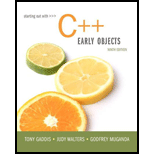
Concept explainers
What type of recursive function do you think would be more difficult to debug; one that uses direct recursion or one that uses indirect recursion? Why?
Recursive Function:
- The function has ability to call itself is called recursion function.
- It is a substitute method for reiteration.
- It replaces the loop statements, so without loop statement it executes the algorithm codes a number of times.
- Selection statement is used to make a decision for the execution of the recursion.
- There are two types of recursive functions. They are:
- Direct recursion
- Indirect recursion
Direct recursion:
When a function calls itself repeatedly until the condition becomes false is called as direct recursion.
Example:
//method definition
void test()
{
//call a function
test();
}
Indirect recursion:
When a function calls another function which in turn calls the same calling function is called as indirect recursion.
Example:
//method definition
void test()
{
//call a function
test1();
}
//method definition
void test1()
{
//call a function
test();
}
Explanation of Solution
Recursion that is difficult to debug:
The recursion that is difficult to debug is “Indirect recursion”.
Justification:
- Because, a function calls one function which is linked to another function.
- Since, a function can make multiple calls to a function; it is difficult to track the flow control of function that is being processed within the code.
Therefore, “Indirect recursion” is difficult to debug when compared to direct recursion.
Want to see more full solutions like this?
Chapter 14 Solutions
Starting Out with C++: Early Objects (9th Edition)
Additional Engineering Textbook Solutions
Computer Science: An Overview (13th Edition) (What's New in Computer Science)
Modern Database Management
BASIC BIOMECHANICS
Java How to Program, Early Objects (11th Edition) (Deitel: How to Program)
SURVEY OF OPERATING SYSTEMS
Java: An Introduction to Problem Solving and Programming (8th Edition)
- Please solve and answer the questions correctly please. Thank you!!arrow_forwardConsidering the TM example of binary sum ( see attached)do the step-by-step of execution for the binary numbers 1101 and 11. Feel free to use the Formal Language Editor Tool to execute it; Write it down the current state of the tape (including the head position) and indicate the current state of the TM at each step.arrow_forwardI need help on inculding additonal code where I can can do the opposite code of MatLab, where the function of t that I enter becomes the result of F(t), in other words, turning the time-domain f(t) into the frequency-domain function F(s):arrow_forward
 C++ Programming: From Problem Analysis to Program...Computer ScienceISBN:9781337102087Author:D. S. MalikPublisher:Cengage LearningProgramming Logic & Design ComprehensiveComputer ScienceISBN:9781337669405Author:FARRELLPublisher:Cengage
C++ Programming: From Problem Analysis to Program...Computer ScienceISBN:9781337102087Author:D. S. MalikPublisher:Cengage LearningProgramming Logic & Design ComprehensiveComputer ScienceISBN:9781337669405Author:FARRELLPublisher:Cengage New Perspectives on HTML5, CSS3, and JavaScriptComputer ScienceISBN:9781305503922Author:Patrick M. CareyPublisher:Cengage Learning
New Perspectives on HTML5, CSS3, and JavaScriptComputer ScienceISBN:9781305503922Author:Patrick M. CareyPublisher:Cengage Learning Systems ArchitectureComputer ScienceISBN:9781305080195Author:Stephen D. BurdPublisher:Cengage Learning
Systems ArchitectureComputer ScienceISBN:9781305080195Author:Stephen D. BurdPublisher:Cengage Learning C++ for Engineers and ScientistsComputer ScienceISBN:9781133187844Author:Bronson, Gary J.Publisher:Course Technology Ptr
C++ for Engineers and ScientistsComputer ScienceISBN:9781133187844Author:Bronson, Gary J.Publisher:Course Technology Ptr





